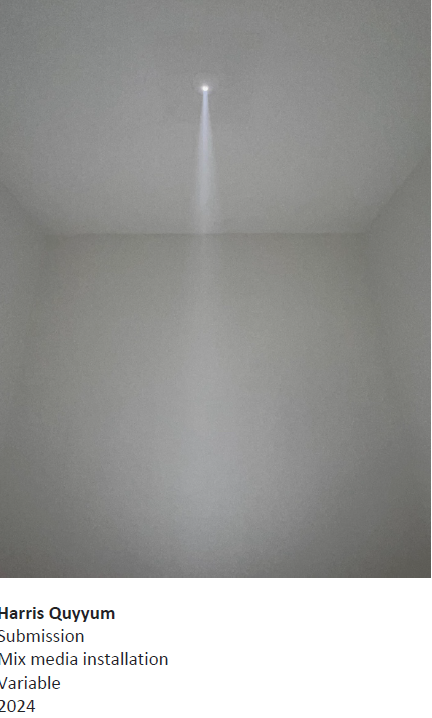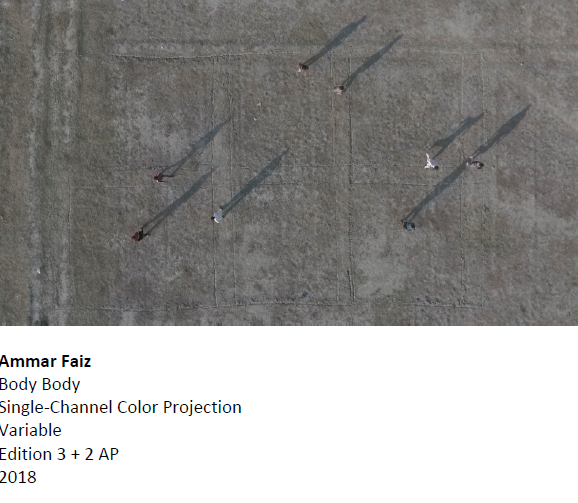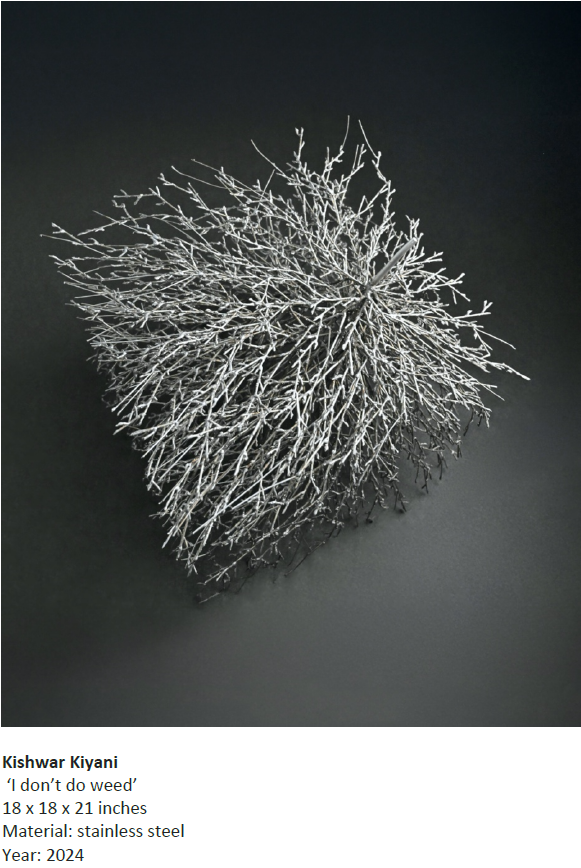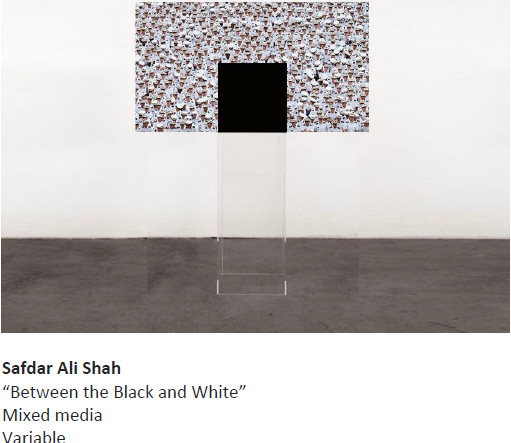Curating the exhibition Back to Basic, (a collateral project of LB 03) is an attempt to comprehend the innumerable interpretations of a basic geometr
Curating the exhibition Back to Basic, (a collateral project of LB 03) is an attempt to comprehend the innumerable interpretations of a basic geometric form
Even long before the invention of chewing gum, a cube has been treated like this malleable stuff. The cube can be stretched to a rectangle; sliced in two, producing a pair of triangles; multiplied to create a pattern; six identical cubes joined together become a three-dimensional form. It can be flipped, reversed, pressed, tilted, twisted, turned, bent, enlarged, minimized etc.; and you can see, touch, pick, keep, or get lost in it.
Cube, single or in multiple combinations, plays an important part in almost every facet of life. Cubes are solid and hollow, inviting and obstructing, physical and invisible, concrete and concepts. One of the basic and archaic forms devised by humans, cube holds sacred, secular, functional, fictional, aesthetic, celebratory, and playful connotations/usage across cultures and continents.
In our urban neighbourhoods, cube has assumed another – essential purpose: to store water in tanks built with bricks and mortar. In a planet bracing for global changes/crisis, cube can acquire an environmental identity, since it saves water for another meal, for the upcoming bath, for the next day, for approaching season, and for the following generation. If the water is a symbol of life, the cube contains that symbol – hence life; so associated with sustainability and our fast receding resources.
Curating the exhibition Back to Basic, (a collateral project of LB 03, being held from 3rd October to 8th November 2024) is an attempt to comprehend the innumerable interpretations, manifestations, and meanings of a simple, familiar and basic geometric form. Artists included in this exhibition have returned to this four-letter word/four-sided object, by extending its possibilities. Works displayed at the Articulated Studios Lahore are investigations into its concepts, historic perspective, tangibility, function, religiousness, materiality, etc. These artworks vary in terms of practice, scale, dimension, medium, format, imagery, ideas, and concerns; thus demonstrating a multiplicity of concepts and contexts in the uniformity of cube. The cube shifts from formal to historical, from spiritual to functional, from flat image to two-dimensional object. The works on display address a range of subjects and themes, including the issue of ecology; the problem of social, economic, and ethnic disparities; the split between solidity and ephemeral, the difference of experiencing a tangible entity, and its recollection lost in the folds of faded histories.

At the Articulate Studios – a compound of 6 cube like spaces – a viewer experiences the immersive installation of Haris Qayyum (Submission), a combination of heartbeats, pale sand, white light, all that invites, surrounds and absorbs a visitor, who in the brief span of staying inside the installation transcends to another reality, guided by the beam of light – nour. The passage to sublime is not an outer journey, but an inner transformation, preserved in the form of an illuminating memory.

Works of art, in a sense, are memories, individual and collective, which play secret games within our psyche. Ammar Faiz presents a popular play, in which a patch of ground is marked into equal measures of squares, and all the participants are enjoying a break of free time in their tough and strenuous life, as they hop, jump, run, and cross over the rudimentarily drawn lines/boundaries. If Faiz’s single-channel video projection, titled Body Body (of an activity observed through a higher viewpoint) alludes to the notions of surveillance, political divide, and the strive to conquer these, it also captures the crisp light of an early morning in Lahore. The work offers another side to a known and tired perception when it comes to division of labour among different sectors of our social order/hierarchy. Those grown up individuals, who according to common presumption spend their hours securing bread for their family by doing meagre jobs; in Faiz’s version are as free, confident and jovial as a certain class indulged in the game of golf.

Another artist, Jovita Alvares employing a personal and pictorial language, unfolds the family archives in her audio-visual media projection, called non (rooted). The sequence of scenes, with a blend of texts, old family photographs, snapshots of unknown origins, weave a narrative that tells the tales of migration, displacement, disorientation, disturbances. An exposure to which not only Alvares, of Goanese heritage, but all of us associate with, since everyone surviving in today’s world is a migrant – from ones’ self, in most cases.

Anila Quayyum Agha, one of the most celebrated artists of Pakistani origin, based in the USA, in her mixed media on paper, Holy Side (Cube) stitches the invisible, but ever-present form of cube. Fabricating a cube is a way of owning it, hence the entire legacy of Islamic geometry, a means to reclaim the past not passed yet; as we exist in multiple times and separate spaces simultaneously.

The sense of space, expanding, contracting, turning, and twisting is apparent in Muhammad Ali Talpur’s four works (on paper, mix media, and metal). Based on the basic form of geometry, these refer to myths, popular visual culture, and religious connotations, yet are dealt with a minimal sensibility. One finds Talpur’s images not physical objects, but their shadows, either the smoke silhouettes, outlines in metal, or empty seashells. Disappearance, whether in the shape of a dark mass of buraq, a sole structure of cube, various lines evolving into a grid, is present in a subtle manner. A similar kind of absence is witnessed in Fatima Haider’s work on paper, Manhole Cover. The dark shape of a usual urban product in its representation could be a holy stone, a prayer rug, yet deeply embedded into darkness.

The disappearance is felt again, in Kishwar Kiani’s stainless steel sculpture, ‘I don’t do weed’. Kiani’s piece, a web of metallic spikes/branches illuminated by a single light, seems to be the inner soul, skin, and core of a non-existent cube, but much present/felt cube.

The same cube, though static and solid, is added in the installation of Safdar Ali Shah, Between Black and White. The group of sailors, clad in the formal attire of navy, are composed in such a scheme that the entire picture turns two-dimensional, further reinforced by the placement of a dense black cube on the eye level. The mixed media work convinces that both the physical object forged in wood and humans made out of flesh and bones, are merely stained marks on flat surfaces.
The interplay of two and three dimensions, of reality and its image, of eternity (of art) and fragility (of a household article) is exposed in Ayaz Jokhio’s Mug Shots, (a sculpture and painting based work made in oil and plastic emulsion on MDF) depicting six views of an empty cup. A complete cup, but empty – inviting the viewers to fill it with their own meanings, perceptions, interpretations.
In fact the premise of Back to Basic is to offer multiple sides of an elementary idea/imagery, through diverse pairs of eyes, and unique minds.

Editor

COMMENTS